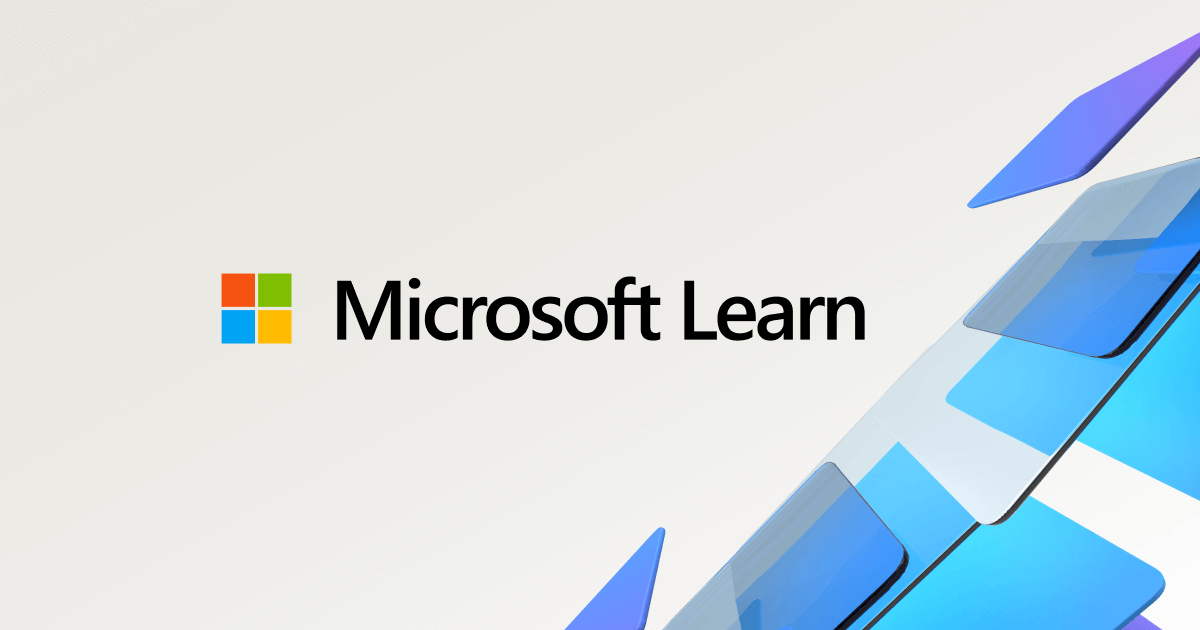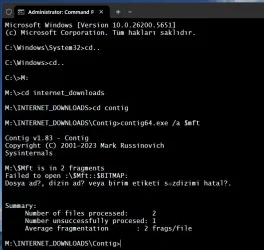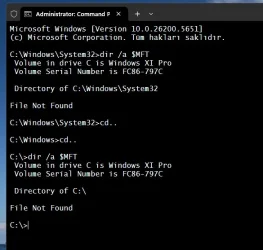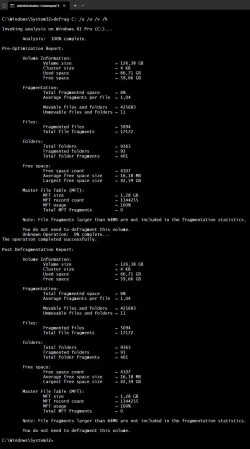- Local time
- 1:05 AM
- Posts
- 173
- OS
- Windows 11 Pro build 26200.5651 (Dev)
Hi all.
Just out of curiosity, I wanted to check if MFT (Master File Table) on NTFS volume was defragmented and how badly.
My purpose to check MFT defragmentation was to decide whether it would be better, if possible, to increase the size of MFT in a given Windows 11 installation.
I found a Microsoft document on how to check MFT: How NTFS reserves space for MFT - Windows Server
I ran the 'dir /a $Mft' command in a command prompt window run as admin as documented in the Microsoft document, it did not yield any result except that it gave me the 'Volume Serial Number' and a 'File Not Found' message.
Then I found another Microsoft document: Contig - Sysinternals
Here I understood Contig.exe would give better results. But I still can't understand the output of Contig.exe. The following screenshot is the output of Contig executable on Windows 11 volume:
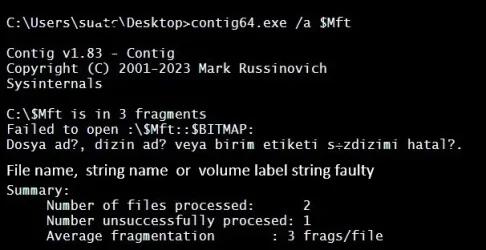
Does anyone have anything else to add here ?
Here is the full list of Contig.exe switches:

Just out of curiosity, I wanted to check if MFT (Master File Table) on NTFS volume was defragmented and how badly.
My purpose to check MFT defragmentation was to decide whether it would be better, if possible, to increase the size of MFT in a given Windows 11 installation.
I found a Microsoft document on how to check MFT: How NTFS reserves space for MFT - Windows Server
I ran the 'dir /a $Mft' command in a command prompt window run as admin as documented in the Microsoft document, it did not yield any result except that it gave me the 'Volume Serial Number' and a 'File Not Found' message.
Then I found another Microsoft document: Contig - Sysinternals
Here I understood Contig.exe would give better results. But I still can't understand the output of Contig.exe. The following screenshot is the output of Contig executable on Windows 11 volume:

Does anyone have anything else to add here ?
Here is the full list of Contig.exe switches:

My Computers
System One System Two
-
- OS
- Windows 11 Pro build 26200.5651 (Dev)
- Computer type
- PC/Desktop
- Manufacturer/Model
- Home Built
- CPU
- Intel i7-4790
- Motherboard
- Asus H97 Pro Gamer with add-on TPM1.2 module
- Memory
- Teams DDR3-1600
- Graphics Card(s)
- MSI Nvidia GeForce GTX 1050Ti
- Sound Card
- Realtek ALC1150
- Monitor(s) Displays
- LG Flatron E2250
- Screen Resolution
- 1920 by 1080 pixels
- Hard Drives
- Crucial NVMe PCIe M2 500 GB (Windows 11 v.24H2); Samsung SSD Evo 870 500 GB (Windows 11 v.24H2);
- PSU
- Corsair HX850
- Case
- Gigabyte Solo 210
- Cooling
- Zalman CNPS7X Tower
- Keyboard
- Microsoft AIO Wireless (includes touchpad)
- Mouse
- HP S1000 Plus Wireless
- Internet Speed
- 200 Mb fiber optic
- Browser
- Chrome; MS Edge
- Antivirus
- Windows Defender
-
- Operating System
- MacOS 12 Monterey
- Computer type
- Laptop
- Manufacturer/Model
- Apple Macbook Air
- CPU
- Intel Core i5
- Memory
- 8 GB
- Graphics card(s)
- Intel integrated
- Screen Resolution
- 1440 by 900 pixels
- Hard Drives
- 128 GB
- Mouse
- Microsoft Wireless
- Keyboard
- Built-in
- Internet Speed
- 802.11 ac
- Browser
- Chrome; Safari
- Antivirus
- N/A

